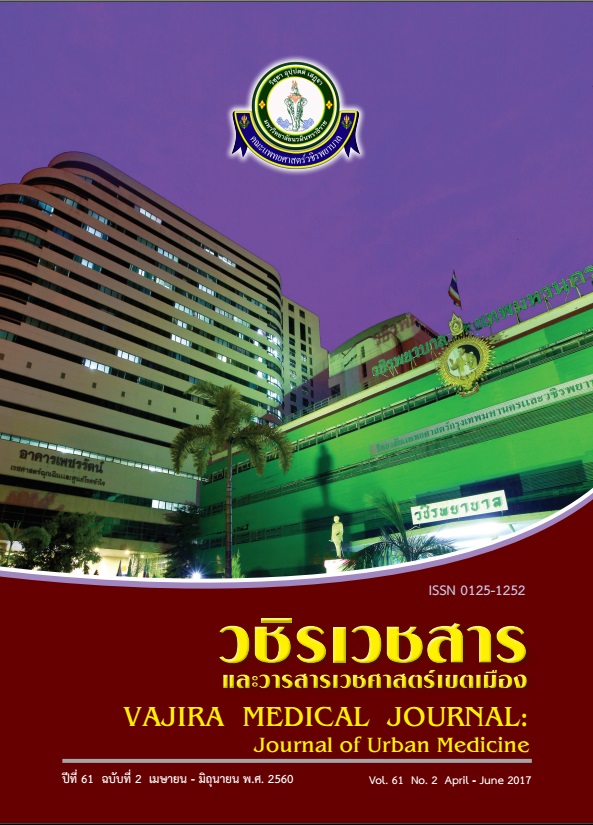The Efficiency of Policy Management on Tuberculosis Prevention and Control in Phetchabun Province
Main Article Content
Abstract
Objectives: The present study investigated the efficiency of policy management on tuberculosis (TB) prevention and control in Phetchabun province.
Method: This study was an action research study. Seventy participants under tuberculosis protection and control were analyzed as qualitative data. TB patients who were registered between 2012 and 2015 were analyzed as quantitative data. Content analysis was used to describe the policy of management on TB prevention and control. Frequency and percentage were used to describe the efficiency of policy management on TB prevention and control.
Results: In Phetchabun province, the rate of active cases finding was on the rise from 49.85% in 2012 to 58.24% and 57.01% in 2015 and 2016, respectively. Mortality rates dropped from 12.68% in 2012 to 11.49%, 11.09% and 10.16% in 2013, 2014 and 2016, respectively. The percentage of hospitals passing the standard of TB clinic increased from 54.5% in 2012 to 100% in 2016. The success rate for treating new TB patients remained constantand below 80%.
Conclusion: This action research demonstrates the efficiency of policy management on TB prevention and control including development of quality of care on DOT standard, active case finding in community, integration between TB and HIV control, development of TB technician and standard laboratory, participation of community, and innovative development for TB convtrol. These measures will make effective policy management for TB prevention and control and therefore should be used to prevent and control TB, and to control risk factors for TB treatment failure.
Downloads
Article Details
References
[Internet]. [cited 2017 Jul 19]. Available from: https://www.newscientist.com/article/dn28405-tuberculosis-now-leading-causeof-death-from-infectious-disease/
2. Houben RMGJ, Dodd PJ. The Global Burden of Latent Tuberculosis Infection: A Re-estimation Using Mathematical Modelling. PLOS Med. 2016 Oct 25; 13(10): e1002152.
3. Thailand Stop TB Partnership: Mitigating the challenges of GFATM grant phasing out - 2-TB (SALT).pdf [Internet]. [cited 2017 Jul 19]. Available from: http://irem2.ddc.moph.go.th/uploads/file/Seminar59/Powerpoint59/2-TB%20 (SALT).pdf
4. Hopewell PC, Fair EL, Uplekar M. Updating the International Standards for Tuberculosis Care. Entering the Era of Molecular Diagnostics. Ann Am Thorac Soc. 2014; 11(3): 277-85.
5. WHO HTM STB 2006.368 eng.pdf [Internet]. [cited 2017 Jul 19]. Available from: http://apps.who.int/iris/bitstream/10665/69241/1/ WHO_HTM_STB 2006.368_eng.pdf
6. Alavi SM, Bakhtiarinia P, Eghtesad M, Albaji A, Salmanzadeh S. A Comparative Study on the Prevalence and Risk Factors of Tuberculosis Among the Prisoners in Khuzestan, South-West Iran. Jundishapur J Microbiol [Internet]. 2014 Dec 1 [cited 2017 May 18]; 7(12). Available from: http://www.ncbi.nlm.nih.gov/pmc/articles/PMC4335546/
7. Eang MT, Satha P, Yadav RP, Morishita F, Nishikiori N, van-Maaren P, et al. Early detection of tuberculosis through community-based active case finding in Cambodia. BMC Public Health. 2012 Jun 21; 12: 469.
8. Dodd PJ, White RG, Corbett EL. Periodic Active Case Finding for TB: When to Look? PLOS ONE. 2011 Dec 22; 6(12): e29130.
9. Sweeney S, Obure CD, Maier CB, Greener R, Dehne K, Vassall A. Costs and efficiency of integrating HIV/AIDS services with other health services: a systematic review of evidence and experience. Sex Transm Infect. 2012 Mar 1; 88(2): 85-99.
10. Ai X, Men K, Guo L, Zhang T, Zhao Y, Sun X, et al. Factors associated with low cure rate of tuberculosis in remote poor areas of Shaanxi Province, China: a case control study. BMC Public Health. 2010; 10: 112.
11. Herrero MB, Ramos S, Arrossi S, Herrero MB, Ramos S, Arrossi S. Determinants of non adherence to tuberculosis treatment in Argentina: barriers related to access to treatment. Rev Bras Epidemiol. 2015 Jun; 18(2): 287-98.
12. Okanurak K, Kitayaporn D, Akarasewi P. Factors contributing to treatment success among tuberculosis patients: a prospective cohort study in Bangkok. Int J Tuberc Lung Dis. 2008 Oct 1; 12(10): 1160-5.
13. Widjanarko B, Gompelman M, Dijkers M, van der Werf MJ. Factors that influence treatment adherence of tuberculosis patients living in Java, Indonesia. Patient Prefer Adherence. 2009 Nov 3; 3: 231-8.
14. Okanurak K, Kitayaporn D, Wanarangsikul W, Koompong C. Effectiveness of DOT for tuberculosis treatment outcomes: a prospective cohort study in Bangkok, Thailand. Int J Tuberc Lung Dis. 2007 Jul 1; 11(7): 762-8.
15. Wright CM, Westerkamp L, Korver S, Dobler CC. Community-based directly observed therapy (DOT) versus clinic DOT for tuberculosis: a systematic review and meta-analysis of comparative effectiveness. BMC Infect Dis [Internet]. 2015 May 8 [cited 2017 May 9]; 15. Available from: http://www.ncbi.nlm.nih.gov/pmc/articles/PMC4436810/
16. Zhang H, Ehiri J, Yang H, Tang S, Li Y. Impact of Community-Based DOT on Tuberculosis Treatment Outcomes: A Systematic Review and Meta-Analysis. PLoS ONE [Internet]. 2016 Feb 5 [cited 2017 May 9]; 11(2). Available from: http://www.ncbi.nlm.nih.gov/pmc/articles/PMC4744041/


